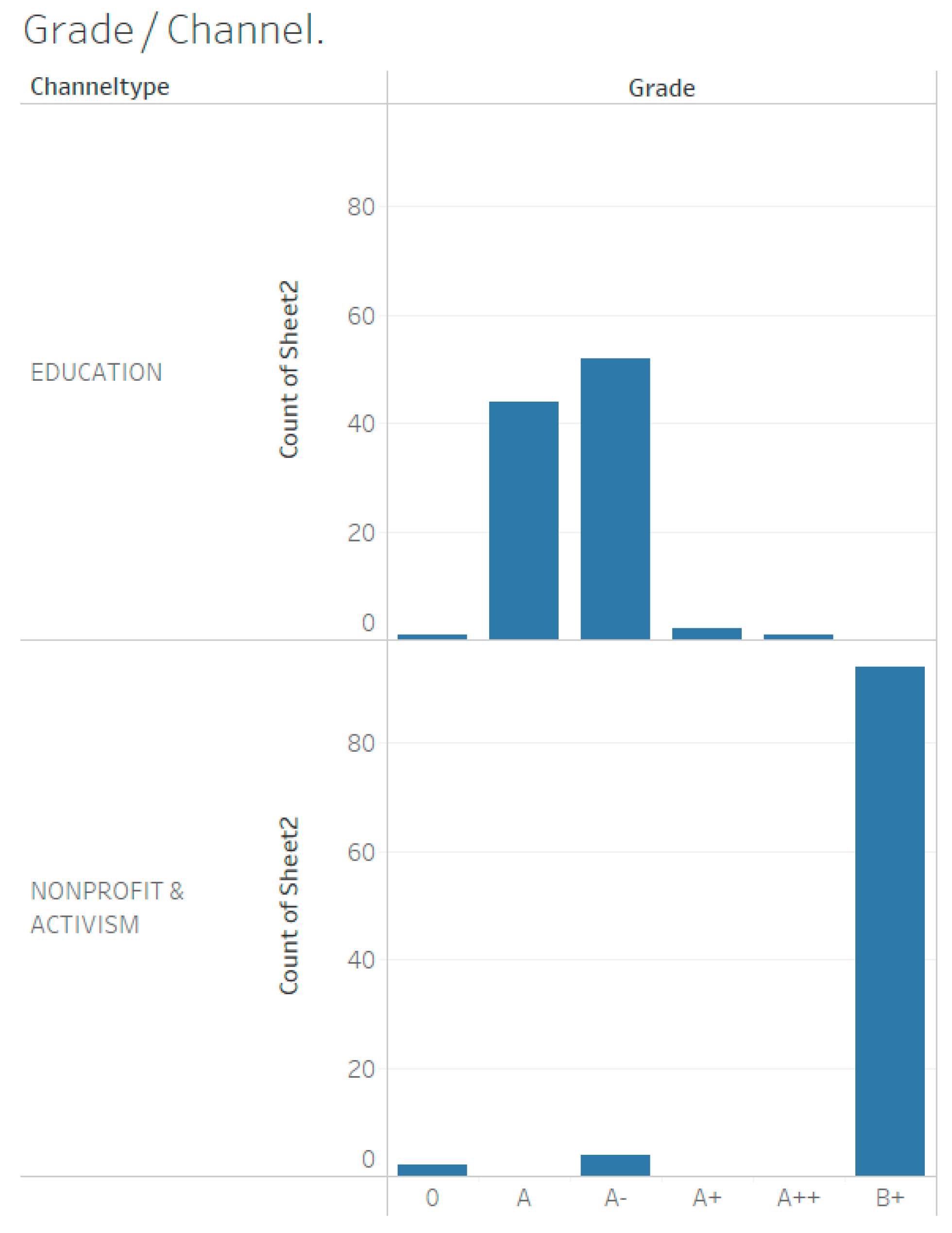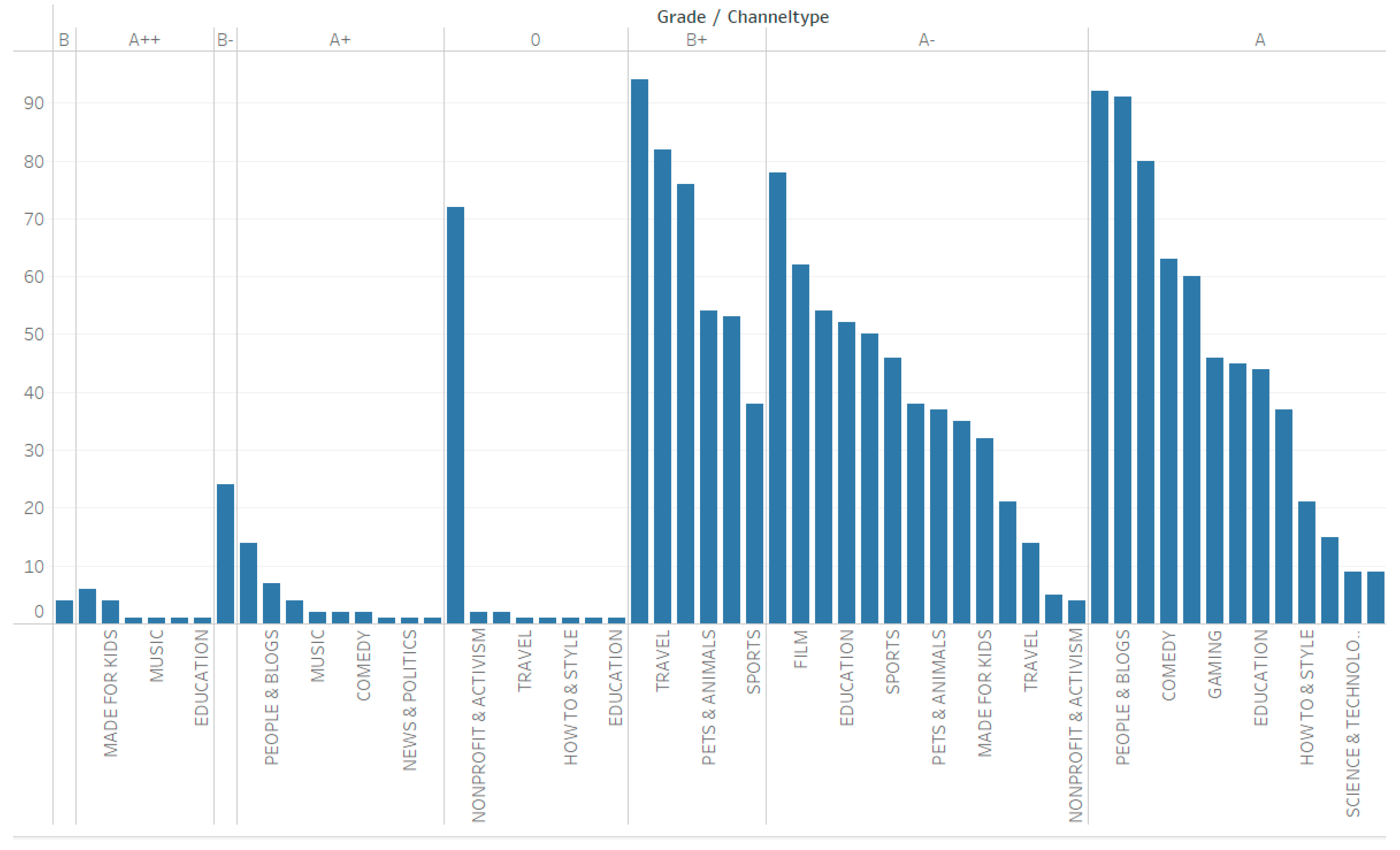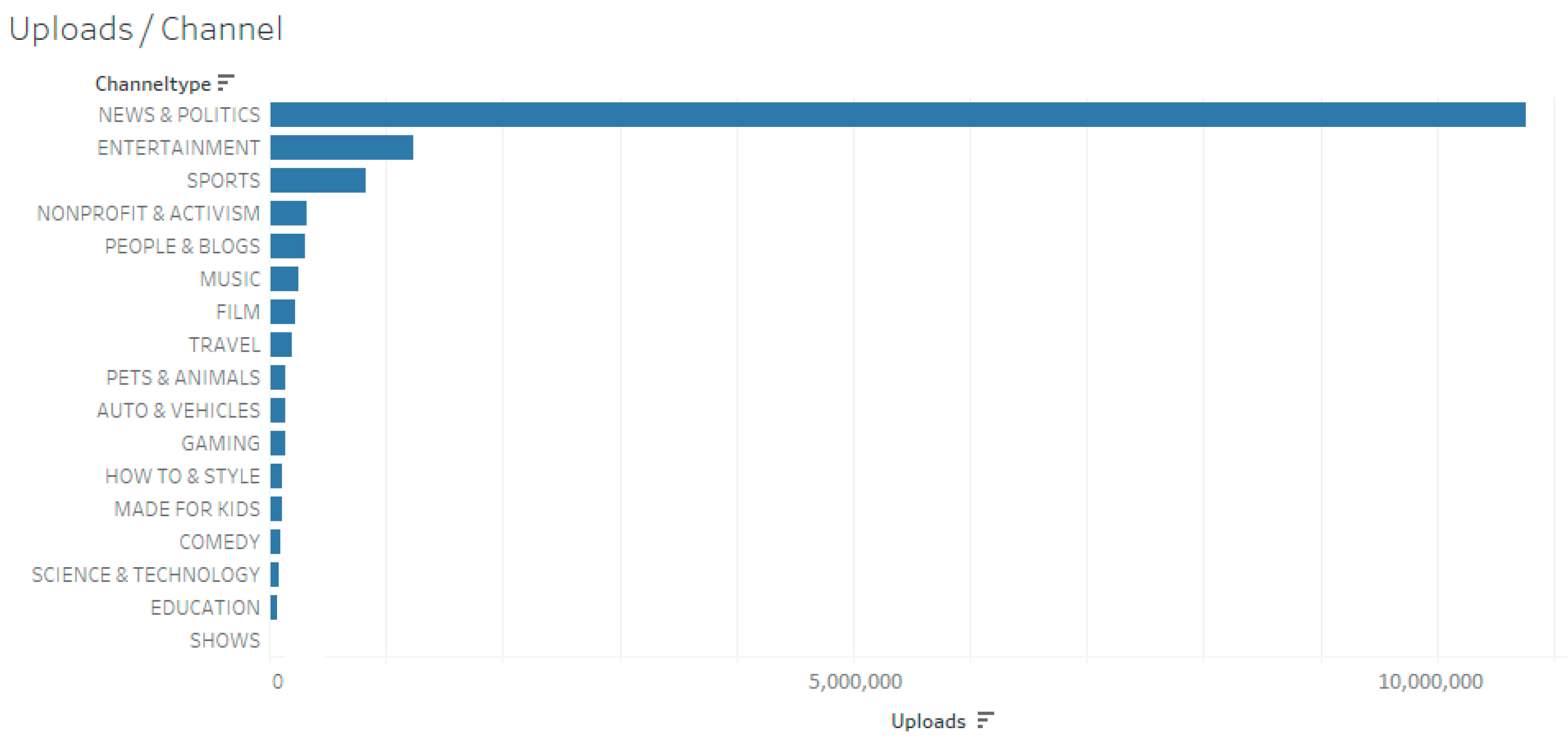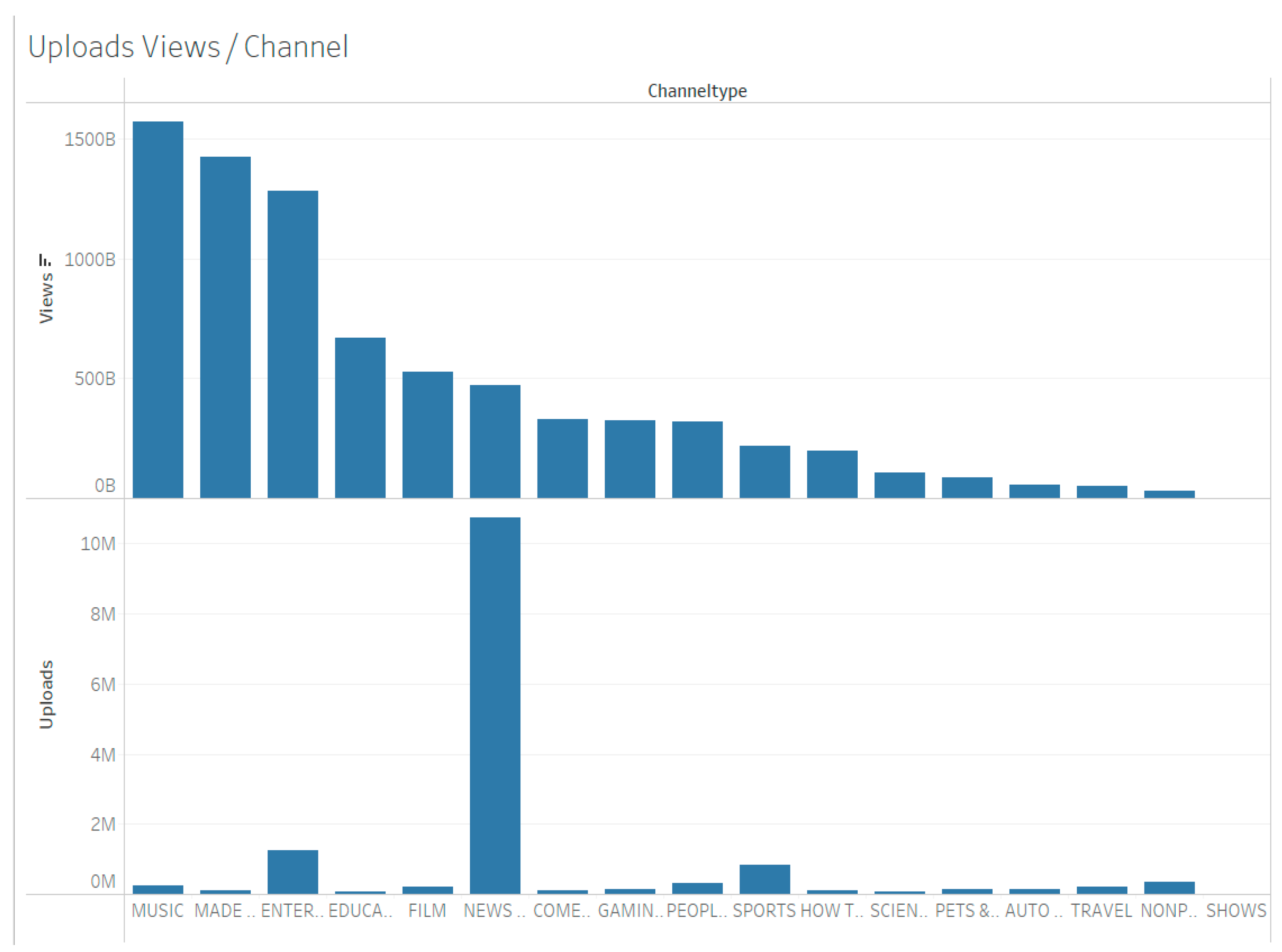YouTube Channels, Subscribers, Uploads and Views: A Multidimensional Analysis of the First 1700 Channels from July 2022
Abstract
1. Introduction
2. Theoretical Background
2.1. Social Media Entrepreneurship
2.2. Factors Influencing Social Media Entrepreneurship
3. Methodology
3.1. The Multidimensional Data Analysis
3.2. The Text Semantic Analysis
4. Results
The Results of The Multidimensional Data Analysis
5. Conclusions
6. Discussion
Author Contributions
Funding
Institutional Review Board Statement
Informed Consent Statement
Data Availability Statement
Conflicts of Interest
References
- Liang, T.; Turban, E. Introduction to the Special Issue Social Commerce: A Research Framework for Social Commerce. Int. J. Electron. Commer. 2011, 16, 5–14. [Google Scholar] [CrossRef]
- Korzynski, P.; Mazurek, G.; Haenlein, M. Leveraging employees as spokespeople in your HR strategy: How company-related employee posts on social media can help firms to attract new talent. Eur. Manag. J. 2020, 38, 204–212. [Google Scholar] [CrossRef]
- Michaelidou, N.; Siamagka, N.T.; Christodoulides, G. Usage, barriers and measurement of social media marketing: An exploratory investigation of small and medium B2B brands. Ind. Mark. Manag. 2011, 40, 1153–1159. [Google Scholar] [CrossRef]
- Aprilia, L.; Wibowo, S.S. The Impact of social capital on crowdfunding performance. South East Asian J. Manag. 2017, 44–57. [Google Scholar] [CrossRef]
- Kaminski, J.; Hopp, C.; Lukas, C. Who benefits from the wisdom of the crowd in crowdfunding? Assessing the benefits of user-generated and mass personal electronic word of mouth in computer-mediated financing. J. Bus. Econ. 2018, 88, 1133–1162. [Google Scholar] [CrossRef]
- Paniagua, J.; Korzynski, P.; Mas-Tur, A. Crossing borders with social media: Online social networks and FDI. Eur. Manag. J. 2017, 35, 314–326. [Google Scholar] [CrossRef]
- Wiedmann, K.P.; Von Mettenheim, W. Attractiveness, trustworthiness and expertise–social influencers ‘winning formula? J. Prod. Brand Manag. 2020, 30, 707–725. [Google Scholar] [CrossRef]
- Hearn, A.; Schoenhoff, S. From celebrity to influencer in A Companion to Celebrity. In A companion to celebrity; Marshall, P.D., Redmond, S., Wiley: London, UK, 2016; pp. 194–212. [Google Scholar]
- Childers, C.C.; Lemon, L.L.; Hoy, M.G. #sponsored #ad: Agency perspective on influencer marketing campaigns. J. Curr. Issues Res. Advert. 2019, 40, 258–274. [Google Scholar]
- Arora, A.; Bansal, S.; Kandpal, C.; Aswani, R.; Dwivedi, Y. Measuring social media influencer index-insights from Facebook, Twitter and Instagram. J. Retail. Consum. Serv. 2019, 49, 86–101. [Google Scholar] [CrossRef]
- Van Der Heide, B.; Lim, Y.S. On the conditional cueing of credibility heuristics: The case of online influence. Commun. Res. 2016, 43, 672–693. [Google Scholar] [CrossRef]
- Valsesia, F.; Proserpio, D.; Nunes, J.C. The Positive Effect of Not Following Others on Social Media. J. Mark. Res. 2020, 57, 1–17. [Google Scholar] [CrossRef]
- Freberg, K.; Graham, K.; McGaughey, K.; Freberg, L.A. Who are the social media influencers? A study of public perceptions of personality. Public Relat. Rev. 2011, 37, 90–92. [Google Scholar] [CrossRef]
- De Vries, L.; Gensler, S.; Leeflang, P.S.H. Popularity of brand posts on brand fan pages: An investigation of the effects of social media marketing. J. Interact. Mark. 2012, 26, 83–91. [Google Scholar] [CrossRef]
- Mardon, R.; Molesworth, M.; Grigore, G. YouTube Beauty Gurus and the emotional labor of tribal entrepreneurship. J. Bus. Res. 2018, 92, 443–454. [Google Scholar]
- Schwemmer, C.; Ziewiecki, S. Social media Sellout: The increasing role of product promotion on YouTube. Soc. Media Soc. 2018, 4, 1–20. [Google Scholar] [CrossRef]
- Ribeiro, M.H.; Ottoni, R.; West, R.; Almeida, V.A.F.; Meira, W. Auditing radicalization pathways on YouTube. In Proceedings of the 2020 Conference on Fairness, Accountability, and Transparency (FAT* ’20), Barcelona, Spain, 27–30 January 2020; Association for Computing Machinery: New York, NY, USA, 2020; pp. 131–141. [Google Scholar] [CrossRef]
- Bounegru, L.; De Pryck, K.; Venturini, T.; Mauri, M. “We only have 12 years”: YouTube and the IPCC report on global warming of 1.5 °C. First Monday 2020, 25, 10112. [Google Scholar] [CrossRef]
- Airoldi, M.; Beraldo, D.; Gandini, A. Follow the algorithm: An exploratory investigation of music on YouTube. Poetics 2016, 57, 1–13. [Google Scholar] [CrossRef]
- Rieder, B.; Matamoros-Fernández, A.; Coromina, Ó. From ranking algorithms to “ranking cultures”: Investigating the modulation of visibility in YouTube search results. Converg. Int. J. Res. Into New Media. Technol. 2017, 24, 50–68. [Google Scholar] [CrossRef]
- Abidin, C. Internet celebrity: Understanding fame online; Emerald: Bingley, UK, 2018; pp. 71–98. [Google Scholar]
- Bishop, S. Managing visibility on YouTube through algorithmic gossip. New Media Soc. 2019, 21, 2589–2606. [Google Scholar]
- Lange, P.G. Publicly private and privately public: Social networking on YouTube. J. Comput. Mediat. Commun. 2007, 13, 361–380. [Google Scholar] [CrossRef]
- Sayago, S.; Forbes, P.; Blat, J. Older people’s social sharing practices in YouTube through an ethnographical lens. In Proceedings of the 26th Annual BCS Interaction Specialist Group Conference on People and Computers (BCS-HCI ’12), Birmingham, UK, 10–14 September 2012. [Google Scholar]
- Kessler, F.; Schäfer, M.T. Navigating YouTube: Constituting a hybrid information management system. In The YouTube Reader; Snickars, P., Vonderau, P., Eds.; Columbia University press: Ney York, USA, 2009; pp. 275–291. [Google Scholar]
- Gillespie, T. The politics of ‘platforms’. New Media Soc. 2010, 12, 347–364. [Google Scholar] [CrossRef]
- Burgess, J.; Green, J. YouTube: Online Video and Participatory Culture, 2nd ed.; Wiley: London, UK, 2018; pp. 36–53. [Google Scholar]
- Lange, P.G. Thanks for Watching: An Anthropological Study of Video Sharing on YouTube; University Press of Colorado: Louisville, CO, USA, 2019. [Google Scholar]
- Arthurs, J.; Drakopoulou, S.; Gandini, A. Researching YouTube. Convergence 2018, 24, 3–15. [Google Scholar] [CrossRef]
- Beautemps, J.; Bresges, A. What comprises a successful educational science YouTube video? A five thousand user survey on viewing behaviours and self-Perceived Importance of Various Variables Controlled by Content Creators. In New Directions in Science and Environmental Communication: Understanding the Role of Online Video-Sharing and Online Video-Sharing Platforms for Science and Research Communication; Allgaier, J., Landrum, A.R., Eds.; Frontiers media SA: Lusanne, Switzerland, 2022; Volume 5, pp. 1–14. [Google Scholar]
- Brennan, E.B.A. Why should scientist be on YouTube? It’s all about bamboo, oil and ice cream. In New Directions in Science and Environmental Communication: Understanding the Role of Online Video-Sharing and Online Video-Sharing Platforms for Science and Research Communication; Allgaier, J., Landrum, A.R., Eds.; Frontiers media SA: Lusanne, Switzerland, 2022; Volume 6, pp. 1–13. [Google Scholar]
- Lewis, R. This is what the news Won’t show you”: YouTube creators and the reactionary politics of micro-celebrity. Telev. New Media 2020, 21, 201–217. [Google Scholar] [CrossRef]
- Kim, H.; Ko, E.; Kim, J. SNS users’ para-social relationships with celebrities: Social media effects on purchase intentions. J. Global Scholars of Marketing Sci. 2015, 25, 279–294. [Google Scholar] [CrossRef]
- Jaakonmäki, R.M.O.; vom Brocke, J. The Impact of Content, Context, and Creator on User Engagement in Social Media Marketing. In Proceedings of the Annual Hawaii International Conference on System Sciences, Hilton Waikoloa Village, HI, USA, 4–7 January 2017; 50, pp. 1152–1160. [Google Scholar]
- Acikgoz, F.; Burnaz, S. The influence of ‘influencer marketing’ on YouTube influencers. Int. J. Internet Mark. Advert. 2021, 15, 201–219. [Google Scholar] [CrossRef]
- Bali, A.O.; Jabar, S.; Jalal, H.; Sofi-Karim, M. Iraqi media entrepreneurs across social media: Factors and challenges. J. Digit. Media Policy 2020, 1–18. [Google Scholar] [CrossRef]
- Ebrahimi, P.; Kot, S.; Fekete-Farkas, M. Platform entrepreneurship: An interpretative structural modeling. Nord. J Media Manag. 2020, 1, 385–400. [Google Scholar]
- Dal Zotto, C.; Omidi, A. Platformization of Media Entrepreneurship: A Conceptual Development. Nord. J. Media Manag. 2020, 1, 209–233. [Google Scholar]
- Khajeheian, D. Enterprise as the central focus in media management research. Nord. J Media Manag. 2020, 1, 1–5. [Google Scholar]
- Sussan, F.; Acs, Z.J. The digital entrepreneurial ecosystem. Small Bus. Econ. 2017, 49, 55–73. [Google Scholar] [CrossRef]
- Alexy, O.T.; Block, J.H.; Sandner, P.; Ter Wal, A.L.J. Social capital of venture capitalists and start-up funding. Small Bus. Econ. 2012, 39, 835–851. [Google Scholar] [CrossRef]
- Liang, Y.E.; Yuan, S.-T.D. Predicting investor funding behavior using crunchbase social network features. Internet Res. 2016, 26, 74–100. [Google Scholar] [CrossRef]
- Yang, S.; Berger, R. Relation between start-ups’ online social media presence and fundraising. J. Sci. Technol. Policy Manag. 2017, 8, 161–180. [Google Scholar] [CrossRef]
- Khamis, S.; Ang, L.; Welling, R. Self-branding, ‘micro-celebrity’ and the rise of social media influencers. Celebr. Stud. 2017, 8, 191–208. [Google Scholar] [CrossRef]
- Paolillo, J.C. Structure and network in the YouTube core. In Proceedings of the 41st Annual Hawaii International Conference on System Sciences (HICSS ’08), Waikoloa, HI, USA, 7–10 January 2008. [Google Scholar]
- Cunningham, S.; Craig, D. Being ‘really real’ on YouTube: Authenticity, community and brand culture in social media entertainment. Media Int. Aust. 2017, 164, 71–81. [Google Scholar] [CrossRef]
- Raun, T. Capitalizing intimacy: New subcultural forms of micro-celebrity strategies and affective labor on YouTube. Convergence 2018, 24, 99–113. [Google Scholar] [CrossRef]
- Goffman, E. Presentation of Self in Every Day life; Penguin books Ltd: London, UK, 1990. [Google Scholar]
- Turner, R.H. The real self: From institution to impulse. Am. J. Sociol. 1976, 81, 989–1016. [Google Scholar]
- Vannini, P.; Franzese, A. The authenticity of self: Conceptualization, personal experience, and practice. Sociol. Compass 2008, 2, 1621–1637. [Google Scholar] [CrossRef]
- Marwick, A.E. Status Update: Celebrity, Publicity, and Branding in the Social Media Age; Yale University Press: New Haven, CT, USA, 2013. [Google Scholar]
- Audrezet, A.; De Kerviler, G.; Guidry Moulard, J. Authenticity under threat: When social media influencers need to go beyond self-presentation. J. Bus. Res. 2020, 117, 557–569. [Google Scholar] [CrossRef]
- Ryan, R.M.; Deci, E.L. Self-determination theory and the facilitation of intrinsic motivation, social development, and well-being. Am. Psychol. 2000, 55, 68. [Google Scholar] [CrossRef]
- Holland, M. How YouTube Developed into a Successful Platform for User-Generated Content. Elon J. Undergrad. Res. Commun. 2016, 7, 53–64. [Google Scholar]
- O’Connor, F. ‘Millenials & Youtube’: An investigation into the influence of user-generated video content on the consumer decision making process. Masters Thesis, National College of Ireland, Dublin, Ireland, August 2016. [Google Scholar]
- Rasmussen, L. Parasocial Interaction in the Digital Age: An Examination of Relationship Building and the Effectiveness of YouTube Celebrities. J. Soc. Media Soc. 2018, 7, 280–294. [Google Scholar]
- Shao, G. Understanding the appeal of user-generated media: A uses and gratification perspective. Internet Res. 2009, 19, 7–25. [Google Scholar] [CrossRef]
- Morreale, J. From homemade to store bought: Annoying Orange and the professionalization of YouTube. J. Consum. Cult. 2014, 14, 113–128. [Google Scholar] [CrossRef]
- Hwang, C.-L.; Yoon, K. Multiple Attribute Decision Making: A State of the Art Survey; Lecture Notes in Economics and Mathematical Systems 186; Springer: Berlin/Heidelberg, Germany, 1981; p. 186. [Google Scholar] [CrossRef]
- Kim, J. The institutionalization of YouTube: From user-generated content to professionally generated content. Media Cult. Soc. 2012, 34, 53–67. [Google Scholar] [CrossRef]
- Rosenthal, S. Motivations to seek science videos on YouTube: Free-choice learning in a connected society. Int. J. Sci. Educ. Part B 2017, 8, 22–39. [Google Scholar] [CrossRef]
- Khan, M.L. Social media engagement: What motivates user participation and consumption on YouTube? Comput. Hum. Behav. 2017, 66, 236–247. [Google Scholar] [CrossRef]
- Nee, R.C. Youthquakes in a post-truth era: Exploring Social media news use and information verification actions among global teens and young adults. J. Mass Commun. Educ. 2019, 74, 171–184. [Google Scholar] [CrossRef]
- Kozinets, R.V.; Cerone, S. Between the suit and the selfie: Executives’ lessons on the social “micro-celebrity”. GfK Mark. Intell. Rev. 2014, 6, 21. [Google Scholar] [CrossRef]
- Drucker, P.F. Innovation and Entrepreneurship: Practice and Principles, New ed.; HarperCollins: New York, NY, USA; Elsevier: Amsterdam, The Netherlands; Butterworth-Heinemann: Oxford, UK, 1999. [Google Scholar]




| Correlation | Value |
|---|---|
| Corr Rank—Subs. | −0.191 |
| Corr Rank—Uploads | −0.074 |
| Corr Rank—Views | −0.200 |
| Corr Subs—Views | 0.920 |
| Corr Uploads—Views | 0.095 |
| Username | Relevance | Relative Relevance | Polarity | Polarity | Type vs. Code |
|---|---|---|---|---|---|
| IDEAL+ | 1 | 100 | 5 | 5 | 1 |
| IDEAL− | 10 | 0 | 1 | 0 |
| Grade | Username | Label | Rank | Relevance | Relative Relevance | Polarity | Polarity Level | Type vs. Code | |||
|---|---|---|---|---|---|---|---|---|---|---|---|
| A | Goldmines Bollywood | Events and Attractions > Cinemas and Events | 1 | 1 | 100 | P+ | 5 | 1 | 0 | 100.489 | 1 |
| B+ | Monkey Magic | Movies > Action and Adventure Movies | 1 | 1 | 100 | P+ | 5 | 1 | 0 | 100.489 | 1 |
| A | Elsa Arca | News and Politics > Crime | 1 | 1 | 100 | P+ | 5 | 0 | 1 | 100.484 | 0.99015 |
| B+ | Jesus Image | News and Politics > Politics | 1 | 1 | 100 | P+ | 5 | 0 | 1 | 100.484 | 0.99015 |
| A | News24 | Business and Finance | 1 | 1 | 100 | P+ | 5 | 0 | 1 | 100.484 | 0.99015 |
| A | SOMOY TV | Hobbies and Interests > Collecting | 1 | 1 | 100 | P+ | 5 | 0 | 1 | 100.484 | 0.99015 |
| A+ | Zee Kids | Travel > Travel Type | 1 | 1 | 100 | P+ | 5 | 0 | 1 | 100.484 | 0.99015 |
| B+ | AutoTopNL | Automotive > Auto Body Styles | 1 | 1 | 100 | P | 4 | 1 | 1 | 100.454 | 0.99014 |
Publisher’s Note: MDPI stays neutral with regard to jurisdictional claims in published maps and institutional affiliations. |
© 2022 by the authors. Licensee MDPI, Basel, Switzerland. This article is an open access article distributed under the terms and conditions of the Creative Commons Attribution (CC BY) license (https://creativecommons.org/licenses/by/4.0/).
Share and Cite
Lupșa-Tătaru, D.A.; Lixăndroiu, R. YouTube Channels, Subscribers, Uploads and Views: A Multidimensional Analysis of the First 1700 Channels from July 2022. Sustainability 2022, 14, 13112. https://doi.org/10.3390/su142013112
Lupșa-Tătaru DA, Lixăndroiu R. YouTube Channels, Subscribers, Uploads and Views: A Multidimensional Analysis of the First 1700 Channels from July 2022. Sustainability. 2022; 14(20):13112. https://doi.org/10.3390/su142013112
Chicago/Turabian StyleLupșa-Tătaru, Dana Adriana, and Radu Lixăndroiu. 2022. "YouTube Channels, Subscribers, Uploads and Views: A Multidimensional Analysis of the First 1700 Channels from July 2022" Sustainability 14, no. 20: 13112. https://doi.org/10.3390/su142013112
APA StyleLupșa-Tătaru, D. A., & Lixăndroiu, R. (2022). YouTube Channels, Subscribers, Uploads and Views: A Multidimensional Analysis of the First 1700 Channels from July 2022. Sustainability, 14(20), 13112. https://doi.org/10.3390/su142013112









